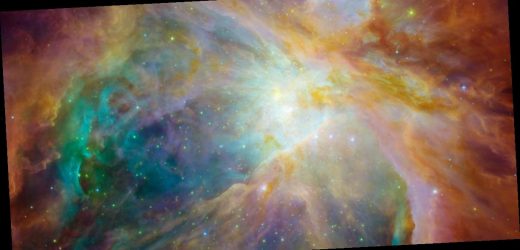- NASA's final "Image of the Day" for 2020 depicts the Orion Nebula, located 1,500 light-years from Earth.
- The Hubble and Spitzer Space Telescopes captured the stunning, colorful image.
- Nebulae are giant clouds of gas and dust where new stars are born.
- Visit Business Insider's homepage for more stories.
NASA decided to share some interstellar fireworks to end an unforgettable year.
The agency posts an "image of the day," every day, and the final image of 2020 did not disappoint.
A canvas of color, NASA's December 31 image of the day depicts a composite image of the Orion Nebula, captured by the Hubble Space and Spitzer Space Telescopes.
It's located more than 1,500 light-years away from Earth.
Nebulae like this one are interstellar nurseries — giant clouds of gas and dust in space that cradle infant stars as they're born. Some nebulae form as stars die: As a star's core cools, it starts to shed its outer layers, which disperse to form gaseous clouds.
A rainbow canvas
To the naked eye, nebulae wouldn't actually look like rainbow canvases peppered with dots of lights (which typically show new stars forming).
When space telescopes like the Hubble image the hydrogen, sulfur, and carbon molecules that make up nebulae like Orion, they don't capture color. Rather, Hubble records particles of light, which NASA can then view through different filters that only let in certain wavelengths of color. Then they assign color to the particles that come through those filters (light than came through the red filter is assigned a red color, for example.)
By combining images of the same nebula viewed with different filters, the agency can create a composite, color image like the ones shown above.
"We often use color as a tool, whether it is to enhance an object's detail or to visualize what ordinarily could never be seen by the human eye," NASA said.
There are roughly 3,000 nebulae in our galaxy.
The closest known nebula to our planet is the Helix Nebula, the cosmic remnant of a dying star. It's about half the distance from Earth as the Orion Nebula is — 700 light-years (so if you traveled at the speed of light, it'd take you 700 years to get there).
The Hubble Space Telescope has been imaging nebulae for 30 years, and these images help scientists learn more about how these cosmic clouds evolve, or even dim and shrink, over time.
Source: Read Full Article


